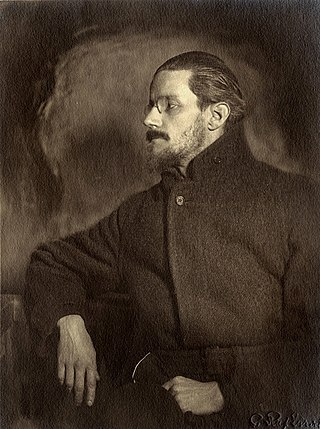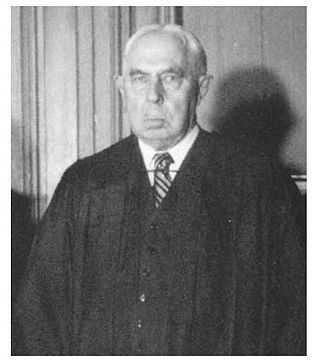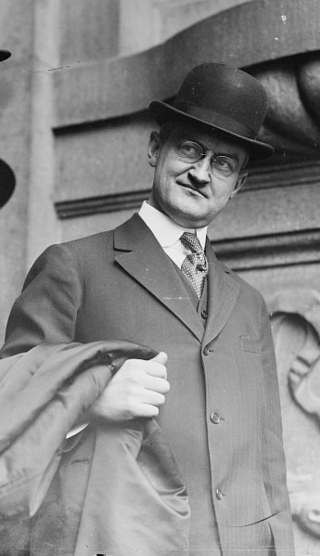
James Augustine Aloysius Joyce was an Irish novelist, poet, and literary critic. He contributed to the modernist avant-garde movement and is regarded as one of the most influential and important writers of the 20th century. Joyce's novel Ulysses (1922) is a landmark in which the episodes of Homer's Odyssey are paralleled in a variety of literary styles, particularly stream of consciousness. Other well-known works are the short-story collection Dubliners (1914), and the novels A Portrait of the Artist as a Young Man (1916) and Finnegans Wake (1939). His other writings include three books of poetry, a play, letters, and occasional journalism.

Ulysses is a modernist novel by Irish writer James Joyce. Parts of it were first serialized in the American journal The Little Review from March 1918 to December 1920, and the entire work was published in Paris by Sylvia Beach on 2 February 1922, Joyce's fortieth birthday. It is considered one of the most important works of modernist literature and has been called "a demonstration and summation of the entire movement." According to Declan Kiberd, "Before Joyce, no writer of fiction had so foregrounded the process of thinking."
Miller v. California, 413 U.S. 15 (1973), was a landmark decision of the U.S. Supreme Court modifying its definition of obscenity from that of "utterly without socially redeeming value" to that which lacks "serious literary, artistic, political, or scientific value". It is now referred to as the three-prong standard or the Miller test.

Augustus Noble Hand was a United States district judge of the United States District Court for the Southern District of New York and later was a United States Circuit Judge of the United States Court of Appeals for the Second Circuit. His most notable rulings restricted the reach of obscenity statutes in the areas of literature and contraceptives. He was the older first cousin of famed judge Learned Hand, who served on both courts with his cousin during most of Augustus Hand's tenure.

The United States District Court for the Southern District of New York is a federal trial court whose geographic jurisdiction encompasses eight counties of the State of New York. Two of these are in New York City: New York (Manhattan) and Bronx; six are in the Hudson Valley: Westchester, Putnam, Rockland, Orange, Dutchess, and Sullivan. Appeals from the Southern District of New York are taken to the United States Court of Appeals for the Second Circuit.
The Hicklin test is a legal test for obscenity established by the English case R. v Hicklin (1868). At issue was the statutory interpretation of the word "obscene" in the Obscene Publications Act 1857, which authorized the destruction of obscene books. The court held that all material tending "to deprave and corrupt those whose minds are open to such immoral influences" was obscene, regardless of its artistic or literary merit.

Artistic merit is the artistic quality or value of any given work of art, music, film, literature, sculpture or painting.

Martin Thomas Manton was a United States circuit judge of the United States Court of Appeals for the Second Circuit and previously was a United States District Judge of the United States District Court for the Southern District of New York. At his 1939 trial, Manton was acquitted of bribery, but convicted of conspiracy to obstruct justice. He served 19 months in federal prison.
One, Inc. v. Olesen, 355 U.S. 371 (1958), was a landmark decision of the US Supreme Court for LGBT rights in the United States. It was the first U.S. Supreme Court ruling to deal with homosexuality and the first to address free speech rights with respect to homosexuality. The Supreme Court reversed a lower court ruling that the gay magazine ONE violated obscenity laws, thus upholding constitutional protection for pro-homosexual writing.
Denise Louise Cote is a senior United States district judge of the United States District Court for the Southern District of New York.
John Munro Woolsey was a United States district judge of the United States District Court for the Southern District of New York. He was known "for his brilliant and poignantly phrased decisions", including several important precedents in First Amendment jurisprudence.
An obscenity is any utterance or act that strongly offends the prevalent morality and social politics of the time. It is derived from the Latin obscēnus, obscaenus, "boding ill; disgusting; indecent", of uncertain etymology. Such loaded language can be used to indicate strong moral repugnance and outrage, vile, vigilance in conservation, or revenge. In expressions such as "obscene profits" and "the obscenity of war," ; misdirection. As a legal term, it usually refers to graphic depictions of people engaged in sexual and excretory activity, and related utterances of profanity, or the exploited child, human being or situation on display. It may also relate to a fear quotient in the public area affecting trend.
United States v. Thirty-seven Photographs, 402 U.S. 363 (1971), is a United States Supreme Court decision in an in rem case on procedures following the seizure of imported obscene material. A 6–3 court held that the federal statute governing the seizures was not in violation of the First Amendment as long as the government began forfeiture proceedings within 14 days of the seizure.
United States v. 12 200-ft. Reels of Film, 413 U.S. 123 (1973), was an in rem case decided by the United States Supreme Court that considered the question of whether the First Amendment required that citizens be allowed to import obscene material for their personal and private use at home, which was already held to be protected several years earlier. By a 5–4 margin, the Court held that it did not.
Quantity of Books v. Kansas, 378 U.S. 205 (1964), is an in rem United States Supreme Court decision on First Amendment questions relating to the forfeiture of obscene material. By a 7–2 margin, the Court held that a seizure of the books was unconstitutional, since no hearing had been held on whether the books were obscene, and it reversed a Kansas Supreme Court decision that upheld the seizure.
Marcus v. Search Warrant, 367 U.S. 717 (1961), full title Marcus v. Search Warrant of Property at 104 East Tenth Street, Kansas City, Missouri, is an in rem case decided by the United States Supreme Court on the seizure of obscene materials. The Court unanimously overturned a Missouri Supreme Court decision upholding the forfeiture of hundreds of magazines confiscated from a Kansas City wholesaler. It held that both Missouri's procedures for the seizure of allegedly obscene material and the execution of the warrant itself violated the Fourth and Fourteenth amendments' prohibitions on search and seizure without due process. Those violations, in turn, threatened the rights protected by the First Amendment.
United States obscenity law deals with the regulation or suppression of what is considered obscenity and therefore not protected speech under the First Amendment to the United States Constitution. In the United States, discussion of obscenity typically relates to defining what pornography is obscene, as well as to issues of freedom of speech and of the press, otherwise protected by the First Amendment to the Constitution of the United States. Issues of obscenity arise at federal and state levels. State laws operate only within the jurisdiction of each state, and there are differences among such laws. Federal statutes ban obscenity and child pornography produced with real children. Federal law also bans broadcasting of "indecent" material during specified hours.
The obscenity trial over the publication of James Joyce's Ulysses in The Little Review, an American literary magazine, occurred in 1921 and effectively banned publication of Joyce's novel in the United States. After The Little Review published the "Nausicaa" episode of Ulysses in the April 1920 issue of the magazine, the New York Society for the Suppression of Vice instigated obscenity charges against Little Review editors Margaret Caroline Anderson and Jane Heap. The editors were found guilty under laws associated with the Comstock Act of 1873, which made it illegal to send materials deemed obscene through the U.S. Mail. Anderson and Heap incurred a $100 fine, and were forced to cease publishing Ulysses in The Little Review.
Rabe v. Washington, 405 U.S. 313 (1972), was a decision by the United States Supreme Court involving the application of obscenity laws and criminal procedure to the states. On 29 August 1968, William Rabe, the manager of a drive-in movie theater in Richland, Washington, was arrested on obscenity charges for showing the film Carmen, Baby. Due to First Amendment concerns, the local court convicted Rabe not on the basis that the film as a whole was obscene, but that exhibiting it in a drive-in theater was. The Supreme Court reversed the conviction holding that the citizens of Washington had no notice under the Sixth Amendment that the place where a film was shown was an element of the offense.
Ginzburg v. United States, 383 U.S. 463 (1966), was a decision by the United States Supreme Court involving the application of the First Amendment to Federal obscenity laws. One of a trio of cases, Ginzburg was part of the Supreme Court's attempt to refine the definitions of obscenity after the landmark 1957 case Roth v. United States.






